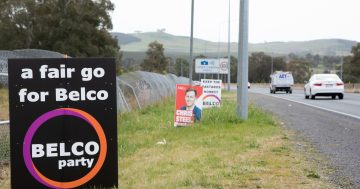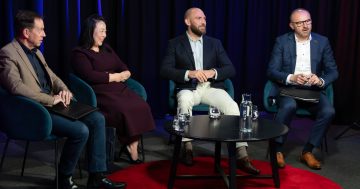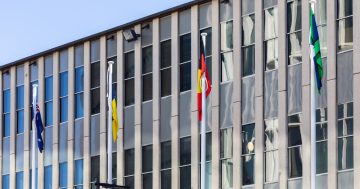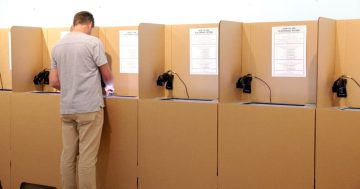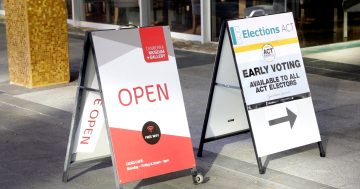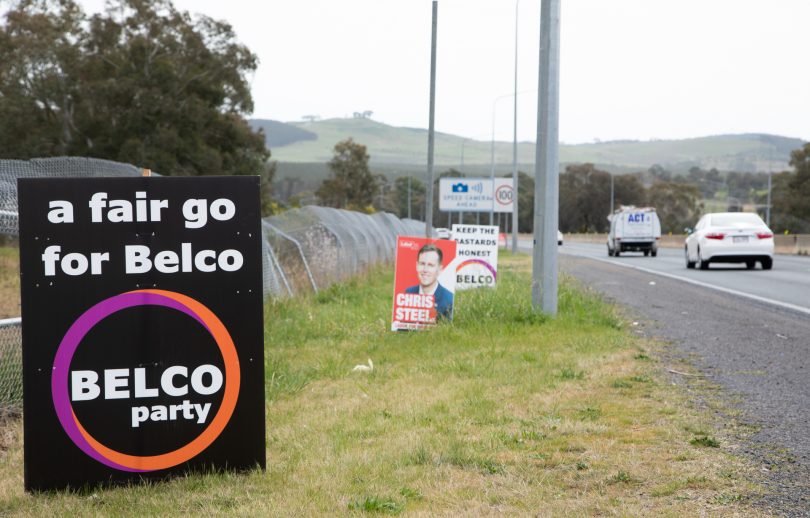
Parties use corflutes because they work. Probably. Photo: Michelle Kroll.
Like the poplar fluff and the swooping magpies, spring elections mean both corflutes and complaints about corflutes. Have you ever wondered, why does Canberra seem to be swamped by these things every election? And is it just us?
Certainly the posters are hard to ignore. Of course, that’s the point – you’re not supposed to ignore them, you’re supposed to pay attention! But why are there so many? Why does it seem like we’re swimming in them?
It comes down to a confluence of three factors: our electoral system, our geography and the culture of Canberra.
The Hare-Clark Five
Canberra uses the Hare-Clark electoral system, and voters choose five members per electorate. Because the voters of each seat have to choose five people, there are more candidates than you’d get in a typical state or federal election.
Because the seats are so small and the candidate pool so large, there’s a glut of advertising around. On top of that, you have to choose all your preferences yourself as each party’s candidates are also running against one another.
One way for a candidate to bust through is name recognition, because there will only usually be a handful of candidates in a seat with any kind of city-wide profile. Everyone else has to hope enough people know them, and the easiest way to do that is to put their name and smiling face in as many places as possible.
Spreading Out
I’ve not counted them and it’s possible we don’t have that many more than you’d find elsewhere, but the corflutes are concentrated so you notice them more. Our seats are some of the smallest in Australia and the posters are crammed in tightly, so they seem overwhelming.
Add to this the way Canberra is laid out. We have town centres, surrounded by suburbs, connected by long arterial roads.
The most common place you see these corflutes is along these major connecting roads like Yamba Drive, the Parkway, or the Monaro. They’re the perfect spots for this kind of advertising – long stretches of blank roadside and no competition for space (except for other corflutes!)
And, of course, we don’t have billboard advertising in Canberra at any other time. That makes the sudden efflorescence of corflutes all the more jarring.
The Bubble
The public sector is the biggest employer in Canberra and a lot of government happens here. While there are plenty of locals who don’t particularly care about the ACT election, the ‘Canberra Bubble’ probably means those that do care tend to care more, and thus the intensity of the advertising is ramped up.
Individual candidates use a lot of social media and direct mail, as well as posters, to get people interested, leaving the TV and radio spots mostly to their leaders and parties. An engaged electorate means there’s more chance a candidate’s message will be heard.
Does it work?
Not a lot of research and analysis is done on ACT elections, and there’s no scientific way to really judge whether or not the corflute-bombing tactic pays off.
My instinct is that it probably does, because of the aforementioned importance of name recognition. Couple this with a basic tenet of advertising in general, and politics: if it didn’t work, they’d stop doing it.
It’s only for a few more days everyone! Hang in there!
Campbell Rhodes is a Canberra writer and political researcher.












